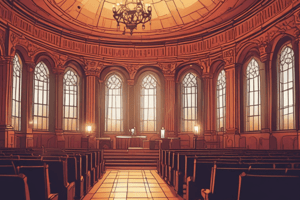Podcast
Questions and Answers
What are the two types of mechanical drawings mentioned for set design?
What are the two types of mechanical drawings mentioned for set design?
- Perspective view and isometric view
- Ground plan view and elevation (correct)
- Axonometric view and orthographic view
- Plan view and section view
Costume designers provide ornamentation which gives the costumes extra detail and ______
Costume designers provide ornamentation which gives the costumes extra detail and ______
style
What are flats and platforms used for in set design?
What are flats and platforms used for in set design?
- Creating walls and levels (correct)
- Lighting effects
- Sound amplification
- Creating special effects
What is the purpose of a storyboard in set design?
What is the purpose of a storyboard in set design?
What is the function of a scrim in set design?
What is the function of a scrim in set design?
The ______ must select fabrics that are appropriate for the construction of the garment
The ______ must select fabrics that are appropriate for the construction of the garment
Costumes can help the audience focus on central ______
Costumes can help the audience focus on central ______
What is the purpose of a cyclorama in set design?
What is the purpose of a cyclorama in set design?
Around 1600, theatre productions began to move indoors and started using gauze and fabric to manipulate the light.
Around 1600, theatre productions began to move indoors and started using gauze and fabric to manipulate the light.
Stage lighting was primarily used for illumination during the day in outdoor theatre productions 2000 years ago.
Stage lighting was primarily used for illumination during the day in outdoor theatre productions 2000 years ago.
The properties of stage lighting include intensity, brightness, color, distribution, and movement
The properties of stage lighting include intensity, brightness, color, distribution, and movement
Jean Rosenthal is known as a pioneer in theatrical lighting design
Jean Rosenthal is known as a pioneer in theatrical lighting design
Costumes can be used to direct the audience’s attention to particular parts of the ______
Costumes can be used to direct the audience’s attention to particular parts of the ______
What are the tools used by a costume designer to direct the audience's attention?
What are the tools used by a costume designer to direct the audience's attention?
______ is important because different fabrics catch stage light in different ways.
______ is important because different fabrics catch stage light in different ways.
Flashcards are hidden until you start studying
Study Notes
The Role of Lighting Design in Theatre
- Jean Rosenthal (1912 - 1969) is a pioneer in theatrical lighting design, formalizing the lighting designer position.
- Gas lights were first installed in London in 1803, had adjustable intensity, but were dangerous and caused fires.
- The lighting designer's process involves script reading, meeting with the director and other designers, and creating a light plot.
- The light plot is a blueprint used by theatrical lighting designers to communicate the lighting design to the director and crew.
- The lighting designer sets cues in a computerized, automated light board during technical rehearsals.
- The primary functions of lighting design are to create a kinesthetic connection, provide visibility, reveal shapes and forms, and establish mood and style.
- Lighting design assists in creating mood, reinforcing style, and establishing time and place.
- The functions of lighting include visibility, shape and form, focus and composition, and mood and style.
- The properties of stage lighting include intensity, brightness, color, distribution, and movement.
- The tools of a lighting designer include the lighting control console, PAR fixtures, Fresnels, ERSs, cyc lights, and automated fixtures.
- Lighting consoles allow control of multiple light fixtures, adjusting brightness, color, and position.
- Sound in theatre involves amplification, stage mics, sound effects, and the use of samples from programs. Sound designers arrange every sound that the audience will hear.
Studying That Suits You
Use AI to generate personalized quizzes and flashcards to suit your learning preferences.




